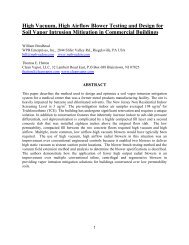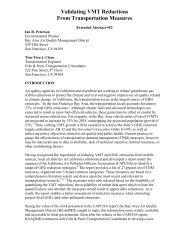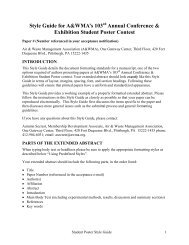Abstract Book
Abstract Book
Abstract Book
Create successful ePaper yourself
Turn your PDF publications into a flip-book with our unique Google optimized e-Paper software.
• Ozone<br />
• PM2.5, both primary and secondary<br />
• Air toxics<br />
• Greenhouse gases<br />
Three key CAP goals are to reduce emissions and decrease ambient concentrations of<br />
harmful pollutants; protect public health by reducing exposure to the most hazardous<br />
pollutants; and protect the climate by reducing GHGs. The CAP proposes 55 control<br />
measures, designed to maximize co-benefits, while minimizing any trade-offs among<br />
pollutants.<br />
To weigh the benefit of reducing different pollutants, BAAQMD developed a multipollutant<br />
evaluation method. The MPEM analyzes how reducing emissions of each<br />
pollutant would affect ambient concentrations, population exposure, and related health<br />
effects. MPEM was used to:<br />
• Estimate health and climate protection benefits, in dollar terms, for each control<br />
measure;<br />
• Estimate aggregate benefit for the entire CAP control strategy;<br />
• Compare the value of reducing one ton of each pollutants (or precursors)<br />
addressed in the CAP.<br />
BAAQMD staff also analyzed air pollutant trends and health risks associated with past<br />
and current levels of air pollution. Key findings regarding reduction in health effects and<br />
increased life expectancy related to improved air quality in the region will be summarized<br />
in the IUAPPA paper. This analysis concludes that PM2.5 poses by far the greatest health<br />
risk from air pollution in the Bay Area.<br />
An Air Pollution Information Network For African (APINA) Perspective On Air<br />
Pollution And Climate Change (203)<br />
S. Baisai Feresu; Institute of Environmental Studies, University of Zimbabwe, Le<br />
Kremlin Bicetre, France<br />
APINA is a network of policy makers, scientists, non-governmental organizations,<br />
industry and other stakeholders interested in air pollution issues formed in 1997. Since<br />
this time, APINA has been interacting with policy makers at both national and regional<br />
level and has facilitated sub-regional policy framework agreements on air pollution<br />
across Africa at ministerial level. The agreements outline measures that will reduce air<br />
pollution across the polluting sectors, such as transport, industry, and open and indoor<br />
burning, and make recommendations for multilateral cooperation, national environmental<br />
governance and capacity building. The potential for air pollution climate change cobenefits<br />
via integrated policies has also been acknowledged but is a difficult issue as most<br />
of Africa has low greenhouse gas (GHG) emissions, yet it is susceptible to some of the<br />
worst effects of climate change.<br />
In Africa, there are potential benefits of integrated air pollution and climate change<br />
policies for particulate matter and tropospheric ozone. Particulate matter can cause<br />
40












